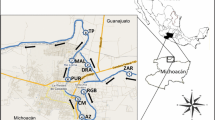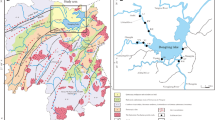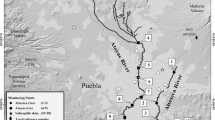Abstract
The Yarlung Tsangbo (YT) is a large river running across southern Tibet and has significant effects on its lower reaches, the Ganges–Brahmaputra Basin. In order to investigate the geochemical features of the YT, 18 surface sediment samples were collected; ten trace element concentrations were measured for bulk sediments and two fine grain size fractions. Meanwhile, basic physicochemical parameters and element concentrations of river water were also analyzed. Results indicated that the river water was alkaline (pH 8.42) and that dissolved oxygen was mainly controlled by river water temperature. Some elements (e.g., Zn and Ni) showed close negative relationship to mean grain size of the sediments. Concentrations of most heavy metals, except As of the YT bulk sediments, were similar to those of Upper Crustal Concentration and its lower reaches, indicating almost no anthropogenic impact. Arsenic of the YT sediments was derived fundamentally from the parent rocks of the YT Basin and was far higher than that of its lower reaches. This indicates that relatively small amounts of As from the study area were transported down to the Brahmaputra River under present, relatively dry climatic conditions. However, more YT sediments might have been transported to its low reaches during the Holocene due to the wet climate, giving high As concentration in Holocene sediments of the Ganges–Brahmaputra Basin. Thus, As transported by the YT may produce important influence on the Ganges–Brahmaputra Basin and contribute to its high As concentration in groundwater.



Similar content being viewed by others
References
Aucour, A. M., France-Lanord, C., Pedoja, K., Pierson-Wickmann, A. C., & Sheppard, S. M. F. (2006). Fluxes and sources of particulate organic carbon in the Ganga-Brahmaputra river system. Global Biogeochemical Cycles, 20, GB2006.
Bibi, M. H., Ahmed, F., & Ishiga, H. (2006). Distribution of arsenic and other trace elements in the Holocene sediments of the Meghna River Delta, Bangladesh. Environmental Geology, 50, 1243–1253.
Brown, E. T., Bendick, R., Bourles, D. L., Gaur, V., Molnar, P., Raisbeck, G. M., et al. (2003). Early Holocene climate recorded in geomorphological features in Western Tibet. Palaeogeography, Palaeoclimatology, Palaeoecology, 199, 141–151.
Casper, S. T., Mehra, A., Farago, M. E., & Gill, R. A. (2004). Contamination of Surface Soils, River Water and Sediments by Trace Metals from Copper Processing Industry in the Churnet River Valley, Staffordshire, UK. Environmental Geochemistry and Health, 26, 59–67.
Chakraborti, D., Mukherjee, S. C., Pati, S., Sengupta, M. K., Rahman, M. M., Chowdhury, U. K., et al. (2003). Arsenic groundwater contamination in Middle Ganga Plain, Bihar, India: A future danger? Environmental Health Perspectives, 111, 1194–1201.
Chakraborti, D., Sengupta, M. K., Rahman, M. M., Ahamed, S., Chowdhury, U. K., Hossain, M. A., et al. (2004). Groundwater arsenic contamination and its health effects in the Ganga-Meghna-Brahmaputra plain. Journal of Environmental Monitoring, 6, 74–83.
Chase, M. E., Jones, S. H., Hennigar, P., Sowles, J., Harding, G. C. H., Freeman, K., et al. (2001). Gulfwatch: Monitoring spatial and temporal patterns of trace metal and organic contaminants in the gulf of maine (1991–1997) with the Blue Mussel, Mytilus edulis L. Marine Pollution Bulletin, 42, 490–504.
Chen, J. S., Wang, F. Y., & Chen, J. L. (1994). Relation of aquatic particulate grain size to heavy metals concentrations in the eastern Chinese rivers. Acta Scentiae Circumstantiae, 14, 419–425.
Cheng, Y. A., & Tian, J. L. (1993). Background value and distribution characteristic of soil elements of Tibetan province. Beijing: Science, 3–45.
Chowdhury, M. A. I., Ahmed, M. F., & Ali, M. A. (2003). Influence of Upstream sediment on arsenic contamination of groundwater in Bangladesh. In K. M. Ahmed, et al. (Eds.), Fate of arsenic in groundwater (pp. 21–36). Japan: Bangladesh University of Engineering, Bangladesh and Technology and United Nations University.
Datta, D. K., & Subramanian, V. (1997). Texture and mineralogy of sediments from the Ganges-Brahmaputra-Meghna river system in the Bengal Basin, Bangladesh and their environmental implications. Environmental Geology, 30, 181–188.
Debon, F. (1986). The four plutonic belts of the Transhimalaya-Himalaya: A chemical, mineralogical, isotopical and chronological synthesis along a Tibet-Nepal section. Journal of Petrology, 27, 219.
Galy, A., & France-Lanord, C. (2001). Higher erosion rates in the Himalaya: Geochemical constraints on riverine fluxes. Geology, 29, 23–26.
Glasby, G. P., Szefer, P., Geldon, J., & Warzocha, J. (2004). Heavy-metal pollution of sediments from Szczecin Lagoon and the Gdansk Basin, Poland. Science of the Total Environment, 330, 249–269.
Goodbred, S. L., & Kuehl, S. A. (2000). Enormous Ganges-Brahmaputra sediment discharge during strengthened early Holocene monsoon. Geology, 28, 1083–1086.
Grosbois, C., Meybeck, M., Horowitz, A., & Ficht, A. (2006). The spatial and temporal trends of Cd, Cu, Hg, Pb and Zn in Seine River floodplain deposits (1994–2000). Science of the Total Environment, 356, 22–37.
Guan, Z. H., Chen, C. Y., Ou, Y. X., Fan, Y. Q., Zhang, Y. S., Cheng, Z. M., et al. (1984). Tibetan Rivers and Lakes (in Chinese) (p. 12). Beijing: Science.
Guillot, S., & Charlet, L. (2007). Bengal arsenic, an archive of Himalaya orogeny and paleohydrology. Journal of Environmental Science and Health Part a-Toxic/Hazardous Substances & Environmental Engineering, 42, 1785–1794.
Hay, W. W. (1998). Detrital sediment fluxes from continents to oceans. Chemical Geology, 145, 287–323.
Horowitz, A. J. (1991). A primer on sediment-trace element chemistry (p. 135). USA: Lewis.
Hren, M. T., Chamberlain, C. P., Hilley, G. E., Blisniuk, P. M., & Bookhagen, B. (2007). Major ion chemistry of the Yarlung Tsangpo-Brahmaputra river: Chemical weathering, erosion, and CO2 consumption in the southern Tibetan plateau and eastern syntaxis of the Himalaya. Geochimica et Cosmochimica Acta, 71, 2907–2935.
Islam, M. R., Salminen, R., & Lahermo, P. W. (2000). Arsenic and other toxic elemental contamination of groundwater, surface water and soil in Bangladesh and its possible effects on human health. Environmental Geochemistry and Health, 22, 33–53.
Li, C. L., Kang, S. C., Zhang, Q. G., & Wang, F. Y. (2009). Rare earth elements in the surface sediments of the Yarlung Tsangbo (Upper Brahmaputra River) sediments, southern Tibetan Plateau. Quaternary International, 28, 151–157.
Ma, M., & Guan, Z. H. (2000). Assessment of water environment of the Yarlung Zangbo Daxiagu and its protection. Geographical Research, 19, 194–201.
McArthur, J. M., Banerjee, D. M., Hudson-Edwards, K. A., Mishra, R., Purohit, R., Ravenscroft, P., et al. (2004). Natural organic matter in sedimentary basins and its relation to arsenic in anoxic ground water: the example of West Bengal and its worldwide implications. Applied Geochemistry, 19, 1255–1293.
Milliman, J. D., Broadus, J. M., & Gable, F. (1989). Environmental and economic implications of rising sea level and subsiding deltas: the Nile and Bengal examples. Ambio Ambocx, 18, 340–345.
Milliman, J. D., & Meade, R. C. (1983). World-wide delivery of river sediment to oceans. Journal of Geology, 91, 1–21.
Milliman, J. D., & Syvitski, J. P. M. (1992). Geomorphic tectonic control of sediment discharge to the ocean—the importance of small mountainous rivers. Journal of Geology, 100, 525–544.
Mitamura, M., Masuda, H., Itai, T. A., Minowa, T., Maruoka, T., Ahmed, K. M., et al. (2008). Geological structure of an arsenic-contaminated aquifer at Sonargaon, Bangladesh. Journal of Geology, 116, 288–302.
Müller, G. (1979). Schwermetalle in den sedimenten des Rheins-Veranderungen seit 1971. Umschau Wiss Tech, 79, 778.
Nozaki, Y., & Alibo, D. S. (2003). Importance of vertical geochemical processes in controlling the oceanic profiles of dissolved rare earth elements in the northeastern Indian Ocean. Earth and Planetary Science Letters, 205, 155–172.
Onishi, H., & Sandell, E. B. (1955). Geochemistry of arsenic. Geochimica et Cosmochimica Acta, 7, 1–33.
Patel, K. S., Shrivas, K., Brandt, R., Jakubowski, N., Corns, W., & Hoffmann, P. (2005). Arsenic contamination in water, soil, sediment and rice of central India. Environmental Geochemistry and Health, 27, 131–145.
Ramesh, R., Ramanathan, A., Ramesh, S., Purvaja, R., & Subramanian, V. (2000). Distribution of rare earth elements and heavy metals in the surficial sediments of the Himalayan river system. Geochemical Journal, 34, 295–319.
Sawyer, E. W. (1986). The influence of source rock type, chemical weathering and sorting on the geochemistry of clastic sediments from the Quetico Metasedimentary Belt, Superior Province, Canada. Chemical Geology, 55, 77–95.
Singh, A. K. (2006a). Chemistry of arsenic in groundwater of Ganges-Brahmaputra river basin. Current Science, 91, 599–606.
Singh, S. K. (2006b). Spatial variability in erosion in the Brahmaputra basin: causes and impacts. Current Science, 90, 1272–1276.
Singh, M., Ansari, A. A., Muller, G., & Singh, I. B. (1997). Heavy metals in freshly deposited sediments of the Gomati River (a tributary of the Ganga River): Effects of human activities. Environmental Geology, 29, 246–252.
Singh, M., Muller, G., & Singh, I. B. (2002). Heavy metals in freshly deposited stream sediments of rivers associated with urbanisation of the Ganga Plain, India. Water, Air, and Soil pollution, 141, 35–54.
Singh, M., Muller, G., & Singh, I. B. (2003a). Geogenic distribution and baseline concentration of heavy metals in sediments of the Ganges River, India. Journal of Geochemical Exploration, 80, 1–17.
Singh, S. K., Reisberg, L., & France-Lanord, C. (2003b). Re-Os isotope systematics of sediments of the Brahmaputra River system. Geochimica et Cosmochimica Acta, 67, 4101–4111.
Smedley, P. L., & Kinniburgh, D. G. (2002). A review of the source, behaviour and distribution of arsenic in natural waters. Applied Geochemistry, 17, 517–568.
Smith, A. H., Lingas, E. O., & Rahman, M. (2000). Contamination of drinking-water by arsenic in Bangladesh: a public health emergency. Bulletin of the World Health Organization, 78, 1093–1103.
Stanger, G. (2005). A palaeo-hydrogeological model for arsenic contamination in southern and south-east Asia. Environmental Geochemistry and Health, 27, 359–368.
Stüben, D., Berner, Z., Chandrasekharam, D., & Karmakar, J. (2003). Arsenic enrichment in groundwater of West Bengal, India: geochemical evidence for mobilization of As under reducing conditions. Applied Geochemistry, 18, 1417–1434.
Subramanian, V., Van’t Dack, L., & Van Grieken, R. (1987). Heavy metal distribution in the sediments of Ganges and Brahmaputra rivers. Environmental Geology, 9, 93–103.
Taylor, S. R., & McLennan, S. M. (1985). The continental crust: Its composition and evolution (pp. 45–49). Oxford: Blackwell.
Xu, R. H. (1985). Magmatism and metamorphism in the Lhasa Block (Tibet): A geochronological study. Journal of Geology, 93, 41–57.
Yang, S. Y., Jung, H. S., Choi, M. S., & Li, C. X. (2002). The rare earth element compositions of the Changjiang (Yangtze) and Huanghe (Yellow) river sediments. Earth and Planetary Science Letters, 201, 407–419.
Zhang, X. P., Deng, W., & Yang, X. M. (2002). The background concentrations of 13 soil trace elements and their relationships to parent materials and vegetation in Xizang (Tibet), China. Journal of Asian Earth Sciences, 21, 167–174.
Acknowledgments
This study was supported by the National Nature Science Foundation of China (40830743, 40771187), the National Basic Research Program of China (2005CB422004), State Key Laboratory of Cryospheric Science (SKLCS-ZZ-2008-01), and the Knowledge Innovation Program of the Chinese Academy of Sciences. The authors acknowledge the staff at NAMOR for great help in the field and thank Feng Chen, Zhiguo Li, and Keming Tian for assistance with sampling and Dr. Xiaoping Wang for providing soil data. Finally, we want to express our thanks to two anonymous reviewers for valuable suggestions.
Author information
Authors and Affiliations
Corresponding author
Rights and permissions
About this article
Cite this article
Li, C., Kang, S., Zhang, Q. et al. Heavy metals in sediments of the Yarlung Tsangbo and its connection with the arsenic problem in the Ganges–Brahmaputra Basin. Environ Geochem Health 33, 23–32 (2011). https://doi.org/10.1007/s10653-010-9311-0
Received:
Accepted:
Published:
Issue Date:
DOI: https://doi.org/10.1007/s10653-010-9311-0




